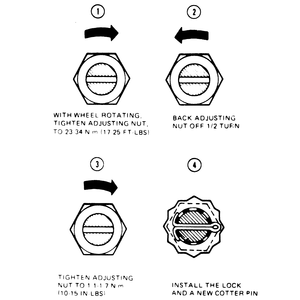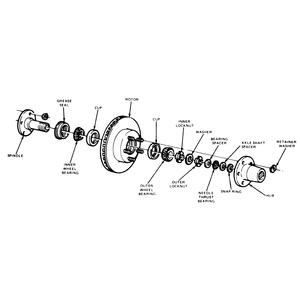| Fig. 1: 2WD wheel bearing adjustment

|
- Raise and support the vehicle safely. Remove the wheel cover. Remove the
grease cap from the hub.
- Wipe the excess grease from the end of the spindle. Remove the cotter pin
and retainer. Discard the cotter pin.
- Loosen the adjusting nut 3 turns.
WARNING
Obtain running clearance between the disc brake rotor surface and shoe linings
by rocking the entire wheel assembly in and out several times in order to
push the caliper and brake pads away from the rotor. An alternate method
to obtain proper running clearance is to tap lightly on the caliper housing.
Be sure not to tap on any other area that may damage the disc brake rotor
or the brake lining surfaces. Do not pry on the phenolic caliper piston.
The running clearance must be maintained throughout the adjustment procedure.
If proper clearance cannot be maintained, the caliper must be removed from
its mounting.
- While rotating the wheel assembly, tighten the adjusting nut to 17–25
ft. lbs. in order to seat the bearings. Loosen the adjusting nut a half turn.
Retighten the adjusting nut 18–20 inch lbs.
- Place the retainer on the adjusting nut. The castellations on the retainer
must be in alignment with the cotter pin holes in the spindle. Once this is
accomplished install a new cotter pin and bend the ends to insure its being
locked in place.
- Check for proper wheel rotation. If correct, install the grease cap and
wheel cover. If rotation is noisy or rough recheck your work and correct as
required.
- Lower the vehicle and tighten the lug nuts to 100 ft. lbs., if the wheel
was removed. Before driving the vehicle pump the brake pedal several times
to restore normal brake pedal travel.
CAUTION
If the wheel was removed, retighten the wheel lug nuts to specification
after about 500 miles of driving. Failure to do this could result in the
wheel coming off while the vehicle is in motion possibly causing loss of
vehicle control or collision.
| Fig. 2: Exploded view of the manual locking hubs and
wheel bearings

|
- Raise the vehicle and install jackstands.
- Remove the wheel and tire assembly.
- Remove the retainer washers from the lug nut studs and remove the manual
locking hub assembly from the spindle.
- Remove the snapring and spacer from the end of the spindle shaft.
- Remove the outer wheel bearing locknut from the spindle using 4 prong spindle
nut spanner wrench, T86T-1197-A or equivalent. Make sure the tabs on the tool
engage the slots in the locknut.
- Remove the locknut washer from the spindle.
- Loosen the inner wheel bearing locknut using 4 prong spindle nut spanner
wrench, tool T86T-1197-A or equivalent. Make sure that the tabs on the tool
engage the slots in the locknut and that the slot in the tool is over the
pin on the locknut.
- Tighten the inner locknut to 35 ft. lbs. (47 Nm) to seat the bearings.
- Spin the rotor and back off the inner locknut 1⁄4 turn.
Install the lockwasher on the spindle. Retighten the inner locknut to 16 inch
lbs. (1.8 Nm). It may be necessary to turn the inner locknut slightly so that
the pin on the locknut aligns with the closest hole in the lockwasher.
- Install the outer wheel bearing locknut using 4 prong spindle nut spanner
wrench, tool T86T-1197-A or equivalent. Tighten locknut to 150 ft. lbs.
- Install the axle shaft spacer.
- Clip the snapring onto the end of the spindle.
- Install the manual hub assembly over the spindle. Install the retainer washers.
- Install the wheel and tire assembly. Install and torque lug nuts to specification.
- Check the end-play of the wheel and tire assembly on the spindle. End-play
should be 0.001–0.003 in. (0.025–0.076mm) and the maximum torque
to rotate the hub should be 25 inch lbs. (2.8Nm).
| Fig. 3: Exploded view of the automatic locking hubs and
wheel bearings

|
- Raise the vehicle and install jackstands.
- Remove the wheel and tire assembly.
- Remove the retainer washers from the lug nut studs and remove the automatic
locking hub assembly from the spindle.
- Remove the snapring and spacer from the end of the spindle shaft.
- Pull the locking cam assembly and the two plastic spacers off of the wheel
bearing adjusting nut.
- Use a magnet and remove the locking key from under the adjusting nut. If
required, rotate the adjusting nut slightly to relieve pressure against the
locking key.
WARNING
To prevent damage to the adjusting nut and spindle threads on vehicles equipped
with automatic hubs, look into the spindle keyway under the adjusting nut
and remove the separate locking key before removing the adjusting nut.
- Loosen the wheel bearing locknut using a 2- 3⁄8 inch
(60.3mm) hex socket, such as Hex Locknut Wrench T70T-4252-B.
- Tighten the inner locknut to 35 ft. lbs. (47 Nm) to seat the bearings.
- Spin the rotor and back off the inner locknut 1⁄4 turn
(90°). Retighten the locknut to 16 inch lbs. (1.8 Nm).
- Align the closest lug in the bearing adjusting nut with the center of the
spindle keyway slot. Advance the nut to the next if required.
- Install the separate locking key in the spindle keyway under the adjusting
nut.
CAUTION
Extreme care must be taken when aligning the adjusting nut with the center
of the spindle keyway slot to prevent damage to the separate locking key.
The wheel and tire assembly may come off while the vehicle is in motion
if the key is damaged.
- Install the two plastic thrust spacers and push or press the cam assembly
onto the adjusting nut by lining up the keyway in the cam assembly with the
separate locking key.
WARNING
Do not damage the locking key when installing the cam assembly.
- Install the axle shaft spacer.
- Clip the snapring onto the end of the spindle.
- Install the manual hub assembly over the spindle. Install the retainer washers.
- Install the wheel and tire assembly. Install and torque lug nuts to specification.
- Check the endplate of the wheel and tire assembly on the spindle. End-play
should be 0.001–0.003 in. (0.025–0.076mm) and the maximum torque
to rotate the hub should be 25 inch lbs. (2.8Nm).
The 1998 B Series Pick-up uses non-adjustable wheel bearings. If the endplate
is not within specifications, the wheel bearings must be replaced. End-play
should be 0.000–0.003 in. (0.00–0.08mm).
The wheel hub/bearing assembly used on both rear- and 4-wheel drive models
is a non-adjustable component. No adjustments can be made, nor are any possible.
However, the wheel bearing can be inspected as follows:
- Raise and support the vehicle safely. Remove the tire and wheel assembly.
- Remove and properly support the caliper assembly.
- Position a dial indicator gauge against the dust cap. Push and pull the
disc brake rotor or brake drum in and out in the axial direction and measure
the end-play of the wheel bearing.
- End-play should not exceed 0.002 in. (0.05mm).
- If end-play is excessive, check the hub nut torque or replace the bearing.

